Graphing Undefined Slope, Zero Slope and More - Answers
The answers are in BOLD below.
NOTE: The transcript from the video is listed below the quiz for your reference.
1. Horizontal lines have a slope that is equal to...
- a fraction
- -1
- undefined
- 1
- 0
2. A line with an undefined slope is a line that goes...
- through the origin
- left and right perfectly flat
- straight up and down
- down from left to right
- up from left to right
3. Which line would have its graph fall exactly on top of the x-axis?
- y=2
- y=-2
- x=2
- x=0
- y=0
4.
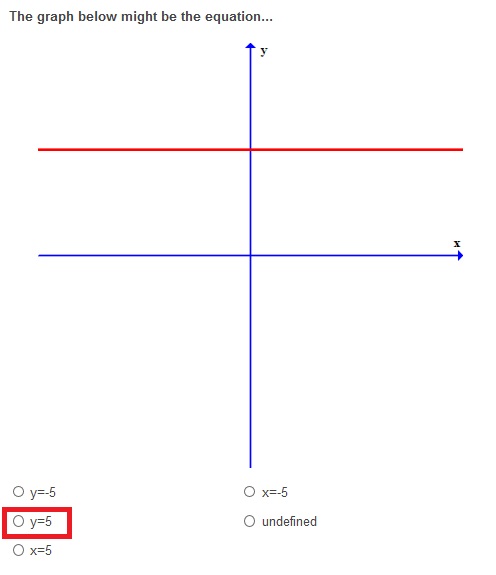
5.

There are two special cases when it comes to lines in the xy plane. Without any additional information, these examples can be pretty confusing. But with a little instruction, they end up being some of the easiest lines to graph!
Zero Slope
This lesson is on what the heck zero slope and undefined slope really mean. They're kind of weird terms that get really confusing and easy to mix up. So let's start with what we know.
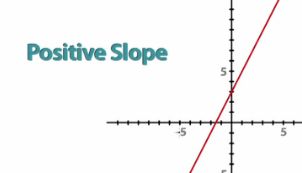 |
We know that lines that go up from left to right have a positive slope and lines that go down have a negative slope. So if I have a steeper line that's going up more than it's going over, this line maybe has a slope of 2, because it has a rise over a run of 2/1. As it gets a little bit flatter, maybe it's only going up 1 for every 1 it's going over, so now it has a slope of 1/1. Then it gets a little bit flatter, so it goes over 2 and up 1, so it has a slope of 1/2.
As it flattens out, the slope might get down to 0.01. Then it flattens out even more and it's 0.001.Then it gets even flatter and it looks like it's almost perfectly flat, but the slope is still 0.0001. As it gets flatter and flatter and flatter, the number gets smaller and smaller and smaller, until the point where it becomes perfectly flat and my slope hits 0.
A zero slope just means that it's a perfectly flat line. It's horizontal. It doesn't go up or down. It's perfectly flat.
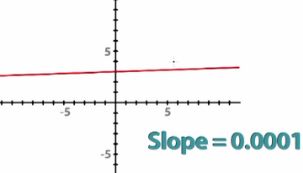 |
This makes sense, right? If it were to go down at all, my slope would become -0.00001. And then if it was a little bit more down, my slope would be -0.01. Then a little more would be -0.1. Then -1, -2, -5 or -10, whatever we want.
So the zero slope is right in between the negative slope lines and the positive slope lines. It's perfectly flat.
Then the question becomes: what's the equation of this line? This is another thing that's really easy to get mixed up. But it turns out that the equation - I should say the equations - of lines that have zero slope are always y equals something .
There are two ways of thinking about this. One way is that it has a zero slope, so you could use the slope-intercept form and say it's y = 0x + b. In this case my y-intercept is 3, so it's 0x + 3. That just means that y = 3, because 0 * x = 0.
But that requires you to know slope-intercept form, and there are a lot of other things going on, and I usually prefer more intuitive ways. The way I think about this is that everywhere on this line, no matter where I pick, y = 3, but x can be anything we want. X could be 4 or -1 or -3 or 10 or -5000. X can be anything that we want, but y always has to be 3. Therefore, my equation is y = 3.
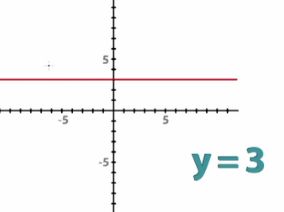 |
Undefined Slope
We can use similar logic to figure out what the slope of a perfectly vertical line is, a line that goes straight up and down. Again, let's start with a line that is kind of normal. It goes over 1 and up 1. It's got a slope of 1/1, which is 1. But then it gets a little bit steeper, so this time it's only going over 1, but it's going up 2; so it's slope is 2/1, or 2. Then maybe it goes over 1 and up 4, so its slope is 4.
Then it gets even steeper and it's got a slope of 10, then maybe 100, maybe 1,000,000. It basically looks like it's going up and down but it's going a tiny bit over. It's just super steep. It's nothing you'd ever want to climb up. But it's not quite vertical.
Then, at the point it hits vertical, it goes from 1,000,000 to 10,000,000 to 99,000,000 to infinity. We hit the point where it doesn't even become a number, but more of just an idea. Because of that, we usually call the slope of vertical lines undefined.
We don't really have a number that describes it. It's kind of infinity. I like to think of it personally as infinity, but it's really just undefined. It's not really a number. So, an undefined slope is a line that goes straight up and down. It's vertical.
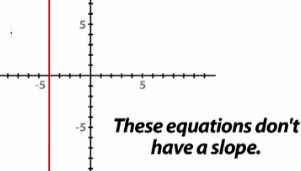 |
So then the question becomes: what are the equations of these lines? As it turns out, these equations, instead of being y =, are going to be x = lines. Again, there are really two ways to think about this.
You can either think about it as these equations don't have a slope, so the normal slope-intercept form, y = mx + b, won't do. It doesn't have a slope, so slope-intercept form is no good, which means it's not y =, it's x =.
But again, that's kind of confusing and I don't personally use that way. I'd rather just think of it as: what are the different points on my line? Well, at this point, x = -4 and y = -2. And at this point, x = -4 and y = 4. At this point, x = -4 and y = -5. Up here, x could be -4 and y could be 100.
On every single one of these points that we pick, x = -4. Y can be anything we want, but x is always -4. Therefore, the equation of it is x = -4.
Lesson Summary
To review, we've got two types of kind of weird lines: ones that go straight left and right, which are horizontal, and ones that go straight up and down, which are vertical. The horizontal ones have a slope of zero, because they're right in between the positives and the negatives. Their equations are y =, because no matter what, y is always the same thing.
Vertical lines have a slope of infinity or, more commonly, an undefined slope. They have equations that are x =, because no matter what, any point on the line has x at the same value. Y can be anything we want, but x is always the same.